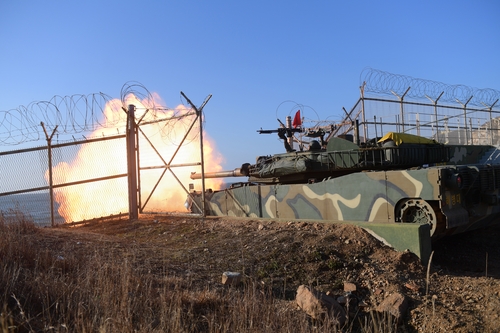- California Assembly OKs highest minimum wage in nation
- S. Korea unveils first graphic cigarette warnings
- US joins with South Korea, Japan in bid to deter North Korea
- LPGA golfer Chun In-gee finally back in action
- S. Korea won’t be top seed in final World Cup qualification round
- US men’s soccer misses 2nd straight Olympics
- US back on track in qualifying with 4-0 win over Guatemala
- High-intensity workout injuries spawn cottage industry
- CDC expands range of Zika mosquitoes into parts of Northeast
- Who knew? ‘The Walking Dead’ is helping families connect
N. Korea fires some 200 artillery shells off western coast: S. Korean military
North Korea fired some 200 artillery shells into waters off its western coast Friday morning, Seoul’s military said, in its latest saber-rattling after it scrapped a 2018 inter-Korean military accord in November.
The move prompted an emergency evacuation order for civilians on the South Korean western border islands of Yeonpyeong and Baengnyeong. Also in response, the South Korean military staged live-fire drills on the border islands.
The Joint Chiefs of Staff (JCS) said it detected the artillery firings from Jangsan Cape and Deungsan Cape, both in the North’s southwestern coastal areas, from 9:00 a.m. to 11 a.m.
The shells splashed into the maritime buffer zone north of the Northern Limit Line (NLL), the de facto maritime border in the Yellow Sea. The buffer zone, where artillery firing and naval drills are banned, was set under an inter-Korean military accord signed on Sept. 19, 2018, to reduce border tensions.
The JCS said there was no reported damage to South Korean citizens and the military or losses of human life from North Korea’s firing.

The South Korean military called the North’s move a “provocative” act and warned of its corresponding measures.
“We gravely warn that the entire responsibility of such crisis-escalating situations lies with North Korea and strongly call for its immediate halt,” JCS spokesperson Col. Lee Sung-jun said in a press conference.
“Under close coordination between South Korea and the United States, our military is tracking and monitoring related activity, and will conduct corresponding measures to North Korea’s provocations.”
In the afternoon, South Korean Marine Corps units on the islands of Baengnyeong and Yeonpyeong staged live-fire exercises, involving K9 self-propelled howitzers and other assets, like K1E1 tanks, against simulated targets in waters south of the NLL, according to defense officials.
The South fired some 400 rounds into the maritime buffer zone, double the amount fired by the North.
The South Korean military fired artillery shots into the buffer zone for the first time since the signing of the 2018 accord. North Korea’s latest firing marked the 16th one of its kind, including a missile launch in 2022.
Pyongyang last fired artillery shots into the maritime buffer zone in the East Sea on Dec. 6, 2022.
Later in the day, the Korean People’s Army (KPA), the North Korean Army’s official name, issued a statement saying units and subunits overseeing the southwestern coastal defense fired 192 shells into five districts as part of a live-fire drill. In an English-language statement carried by the Korean Central News Agency, the KPA claimed it was “a far-fetched assertion” on South Korea’s part to claim North Korea had fired shells into the buffer zone near Yeonpyeong and Baengnyeong islands.
The KPA also said its drill on Friday was “a sort of natural countermeasure” against recent artillery firings by South Korea.
South Korea’s Army had said Thursday that South Korea and the United States held a joint live-fire exercise near the border with North Korea, aimed at bolstering their combined operational capabilities against North Korea’s military threats.
North Korea on Friday warned against such provocations under the guise of shoring up readiness, saying its armed forces will demonstrate “tough counteraction on an unprecedented level.” The KPA also referred to the South Korean Army as “the military gangsters.”
Defense Minister Shin Won-sik presided over the South’s drills virtually from the JCS’ command post in central Seoul and called for readiness against “reckless provocative” acts by the North.
“Our military … needs to be equipped with a retaliatory posture for complete annihilation so that the enemy never attempts another provocation and to ensure peace through powerful strength,” he was quoted as saying.
Last November, North Korea unilaterally scrapped the 2018 accord after Seoul partially suspended the deal in protest of the North’s successful launch of a military spy satellite.
The 2018 accord, signed under the previous liberal President Moon Jae-in, was designed to dial down military tensions, prevent accidental clashes and build mutual trust.
It included setting up maritime buffer zones, a land buffer zone banning artillery drills and regiment-level field maneuvers, as well as no-fly zones near the border to prevent accidental aircraft clashes.
North Korea’s latest saber-rattling came after North Korean leader Kim Jong-un defined inter-Korean ties as relations “between two states hostile to each other” and called for stepped-up preparations to “suppress the whole territory of South Korea” at a year-end ruling party meeting.
South Korea’s spy agency said last month that North Korea is highly likely to carry out military provocations or cyberattacks in early 2024 ahead of the South’s parliamentary election in April and the U.S. presidential election in November.








![일본 사도광산 [서경덕 교수 제공. 재판매 및 DB 금지]](http://www.koreatimesus.com/wp-content/uploads/2024/07/PYH2024072610800050400_P4-copy-120x134.jpg)


